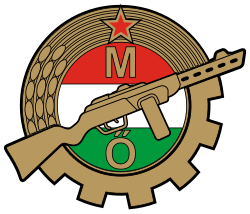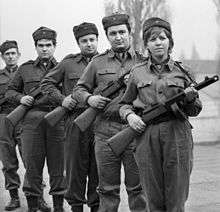Workers' Militia
The Workers' Militia (Hungarian: Munkásőrség) was a paramilitary organization in the Hungarian People's Republic from 1956 to 1989.



History
Pre-1956
Similar worker-guard organizations existed before 1956 in various socialist countries, partly to the circumvent closing of the Second World War peace treaties (such as the German Democratic Republic's Kampfgruppe squads), in part to provide more actionable, non-regular "popular" groups than the armed forces (such as the Lidové Milice of Czechoslovakia).
Formation
Following the quelled Hungarian Revolution of 1956, the Revolutionary Workers'-Peasants' Government ordered on February 18, 1957 the formation of the Workers' Militia. It replaced the revolutionary regime's special police force (karhatalom or also known as pufajkások, named after their Soviet-style quilted jackets). The slate-grey uniformed and armed Militia's aim was to defend the means of production. It was a voluntary service, but obviously offered some career advantages. Starting with 20,000 members, it gradually developed into a large armed force (60,000 strong in 1988[1]), although they were never deployed.
The first commander of the organization was Lajos Halász (1957–1962), followed by Árpád Papp (1962–1970), then lastly Sándor Borbély (1970–1989).
On October 31, 1989, a referendum was held with the question: "Should the Workers' Militia be disbanded?". The answer was an overwhelming Yes (94.9%), a result which confirmed the previously-adopted law (1989 XXXth).
Ranks
Body position markings
| Insignia |
|||||||||||||
|---|---|---|---|---|---|---|---|---|---|---|---|---|---|
| Title | Főrevizor | Főügyeletes | Főügyeletes-helyettes | Kapuügyeletes | Csoportvezető | Szolgálatvezető | Törzscsoport munkatárs | Törzscsoport közvetlen állomány | Egységtörzs munkatárs I. | Egységtörzs munkatárs II. | Egységtörzs munkatárs III. | Egységtörzs állomány | Beosztott állomány |
| English | Controller | The main on call | Principal deputy on duty | Gate duty | Group leader | Service Director | Core group associate | Strain group direct stock | Unit Staff Fellow I | Unit Staff Fellow II | Unit Staff Fellow III | Unit stock | Subordinate staff |
Command position markings
| Insignia |
||||||||||||||
|---|---|---|---|---|---|---|---|---|---|---|---|---|---|---|
| Title | Országos parancsnok | Országos parancsnok-helyettes | Parancsnok | Parancsnok-helyettes | Csoportvezető főtiszt | Egységparancsnok | Egységparancsnok-helyettes | Szolgálatvezető | Beosztott századparancsnok-helyettes | Század szolgálatvezető | Szakaszparancsnok | Szakaszparancsnok-helyettes | Rajparancsnok | Beosztott munkásőr állomány |
| English | National Commander | Deputy National Commander | Commander | Deputy Commander | Group Chief Officer | Unit Commander | Deputy Unit Commander | Service Director | Deputy Commander in Chief | Century Chief of Staff | Platoon Commander | Deputy Section Commander | Squad Leader | Subordinate worker guard |
See also
Similar formations:
- State Defense Forces
- Territorial Army (United Kingdom)
- United States National Guard
- Territorial Defense Force
- People's Militias
- Combat Groups of the Working Class
- ORMO
- Patriotic Guards
- Worker-Peasant Red Guards